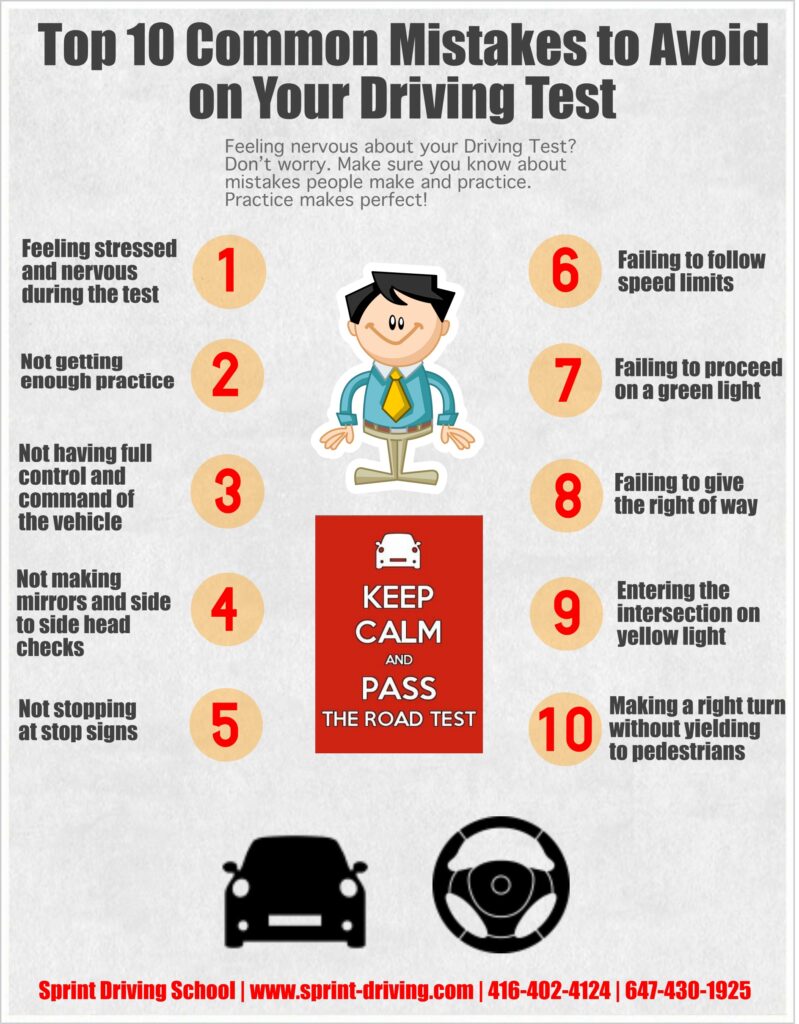Over 40% of road test failures are due to simple mistakes that could have been easily avoided with a bit of extra preparation. This shocking statistic underscores the importance of understanding common errors that can derail a driving test. Unfortunately, even experienced drivers can falter under the pressure of examination conditions, highlighting the need for calm and precision during the test.
One of the most significant aspects of mastering a road test is how well the driver adheres to safety protocols, especially when it comes to proper signaling. Historically, neglecting to use turn signals or failing to check blind spots has ranked highest in errors committed. Such lapses not only result in failing the test but also pose real dangers on the road, emphasizing the necessity for thorough practice and awareness. Including consistent practice in these areas can significantly improve test outcomes.

What is the most common mistake in a road test?
One of the most common mistakes during a road test is improper use of turn signals. Many drivers forget to signal when making turns or changing lanes. This error can lead to automatic failure. Using signals correctly is crucial as it ensures safety by informing other drivers of your intentions. It’s a simple habit that can make a big difference.
Another frequent mistake is failing to check mirrors and blind spots. This oversight happens when drivers feel rushed or under pressure. In a test, not checking mirrors can result in missed observations. Test examiners watch for this closely. Regular practice can help embed this vital safety check into driving behavior.
Speed management is also a common area where drivers falter. Exceeding or falling significantly below speed limits shows a lack of control. It’s essential to maintain appropriate speed, especially in school zones and residential areas. Knowing when to adjust speed based on road conditions demonstrates awareness and competence.
A significant number of test fails are attributed to nervousness and overthinking. Many candidates struggle to maintain calm under test conditions. This anxiety can lead to simple errors, such as missing stop signs or poorly timed turns. Relaxation techniques and thorough preparation can help reduce this stress. Confident and composed driving is essential for success.
Understanding Signal and Mirror Usage Errors
Improper signal and mirror usage can be a significant issue during a road test. Many drivers either forget to signal or signal too late. This miscommunication can lead to accidents or confusion on the road. Failing to signal during lane changes or turns can result in automatic test failure. Proper signaling indicates a driver’s intentions and keeps everyone safer.
Checking mirrors is another area where errors frequently occur. Drivers often forget to check their mirrors regularly. This is especially critical when changing lanes or merging. Not checking mirrors can cause collisions or near-misses. Mirror checks should become a natural and regular part of driving.
Young drivers may struggle with understanding when to use different mirrors. The rearview mirror is for seeing traffic behind. Side mirrors help with blind spots. Knowing how to use all mirrors effectively is a crucial skill. It helps drivers stay aware of their surroundings and avoid potential hazards.
Signal and mirror use mistakes are common due to nerves or inexperience. Practice can help build these habits. Instructors often emphasize the importance of these actions. By repeatedly practicing these skills, drivers can improve their road test performance. Consistent use of signals and mirrors leads to safer driving overall.
Examining the Impact of Improper Lane Usage
Improper lane usage during a road test can have serious consequences. One common mistake is drifting between lanes without signaling. This behavior can confuse other drivers and lead to potential accidents. Lane discipline is crucial for road safety. Test examiners pay close attention to how well candidates stay within their lane.
Frequent lane changes without signaling can also be problematic. This creates an unpredictable environment for other road users. Proper lane usage involves making smooth and deliberate lane changes. Drivers should always check their mirrors and blind spots. Signaling intentions early helps communicate with others on the road.
Incorrect use of turn lanes is another issue to consider. Some drivers mistakenly use straight lanes to turn, or vice versa. This can disrupt the flow of traffic and cause dangerous situations. Understanding road markings and signs can help prevent these errors. Practicing in different driving conditions can build confidence in lane usage.
Staying in the incorrect lane for an extended period is a critical mistake. For example, staying in a left-turn lane when planning to go straight. These errors show a lack of road awareness. Developing good habits through instruction and practice is key. Correct lane usage ensures smoother traffic flow and enhances safety for everyone.
Speed Management During the Road Test
Speed management is a crucial aspect of passing a road test. Driving too fast or too slow can both result in penalty points. Maintaining a safe speed is important, particularly in residential areas and school zones. Examiners look for how well candidates adhere to speed limits. Proper speed also shows awareness of road conditions and traffic flow.
Understanding when to accelerate and decelerate is key. For example, when approaching a stop sign or traffic light, it’s important to slow down smoothly. Abrupt braking can be dangerous and indicate poor speed management. On the other hand, accelerating too quickly can make the vehicle hard to control. Controlled acceleration and smooth braking demonstrate safe driving skills.
Many drivers struggle with maintaining a consistent speed on highways. It’s essential to stay within the speed limit while keeping pace with traffic. Using cruise control, where allowed, can help maintain a steady speed. Examiners note how well drivers adapt to different speed limits. Consistency in speed management is a sign of an experienced driver.
Being aware of changing speed limits is another critical factor. For instance, transitioning from a highway to a residential area requires adjusting speed accordingly. Missing speed limit signs can lead to exceeding the limit inadvertently. Practicing in various environments can enhance speed awareness. This adaptability is crucial for passing the road test.
Speed management also involves responding to unexpected situations. Drivers need to adjust their speed quickly for sudden obstacles or changes in traffic flow. Anticipating potential hazards and reacting appropriately are vital skills. These abilities are tested thoroughly during the road exam. Being prepared helps ensure both immediate safety and long-term driving success.
Role of Nervousness and Overthinking
Nervousness can play a significant role in road test performance. Many candidates feel anxious due to the pressure of being evaluated. This anxiety can lead to mistakes like hesitating at stop signs or making abrupt stops. Overthinking every action can cause delays in decision-making. Staying calm and focused is crucial for smooth performance.
Overthinking can often result from a lack of confidence in driving abilities. When drivers second-guess their actions, they are more likely to make errors. For example, constantly checking mirrors might cause them to miss important changes in traffic signals. It’s essential to strike a balance between caution and confidence. Practicing driving can help in building this trust in one’s skills.
Nervousness may also manifest physically, causing issues like shaky hands or sweaty palms. These symptoms can interfere with the control of the vehicle. It’s crucial to address these signs of stress before the exam. Simple techniques like deep breathing can help calm nerves. Staying physically relaxed can improve overall control and performance.
Examiners are trained to recognize signs of nervousness and overthinking. Fortunately, they often provide instructions carefully and clearly to help candidates relax. Following these instructions attentively can make a significant difference. If you’re unsure about something, it’s okay to ask for clarification. Clear communication helps in reducing stress and errors.
Another approach to managing nervousness is simulating test conditions during practice sessions. By replicating the pressure of a real test, candidates can better prepare themselves mentally. Familiarity with the format and expectations can enhance confidence. Regular practice under these conditions can make the actual test feel less intimidating. Preparation is key to overcoming nervousness.
Correcting Mistakes with Proper Training and Preparation
Proper training and preparation are essential for correcting mistakes in driving. Engaging in regular practice sessions allows drivers to address their weaknesses. A structured approach to learning can significantly improve driving skills. For instance, practicing turns, stops, and parking maneuvers can refine these actions. Consistent practice builds confidence and competence.
Working with a qualified driving instructor is beneficial. Instructors provide guidance and feedback tailored to individual needs. They can identify specific areas where improvement is needed. Lessons often cover all aspects of driving, from basic controls to complex situations. This comprehensive training ensures a well-rounded preparation.
Simulating test conditions during practice can be very effective. This helps drivers get accustomed to the pressure they will face during the actual test. It’s important to follow the same rules and procedures as in a real test. Practicing in various weather and traffic conditions adds to the realism. This readiness can significantly reduce anxiety.
Utilizing online resources and study materials can supplement practical training. Many websites offer tutorials and quizzes on road rules and safe driving practices. These tools can reinforce what has been learned during lessons. Having a strong grasp of theoretical knowledge supports better decision-making on the road. Combining both theory and practice helps in correcting mistakes.
Reviewing mistakes and understanding why they happened is crucial. Drivers should take note of any errors and devise strategies to avoid them in the future. Keeping a driving journal can help track progress and areas that need more attention. Reflecting on each practice session ensures continuous improvement. Learning from mistakes is a key part of the driving journey.
Conclusion
Understanding the common mistakes in a road test, such as improper signaling, lane usage, and speed management, is essential for success. Addressing the role of nervousness and overthinking helps reduce errors under test conditions. Proper training and preparation can significantly enhance driving skills and confidence. Focused practice leads to safer and more reliable driving.
By incorporating these insights and strategies, candidates can improve their road test performance. Instructors play a crucial role in providing guidance and feedback. Consistent practice and learning help correct mistakes and build good driving habits. Ultimately, thorough preparation ensures a safer driving experience for everyone.

